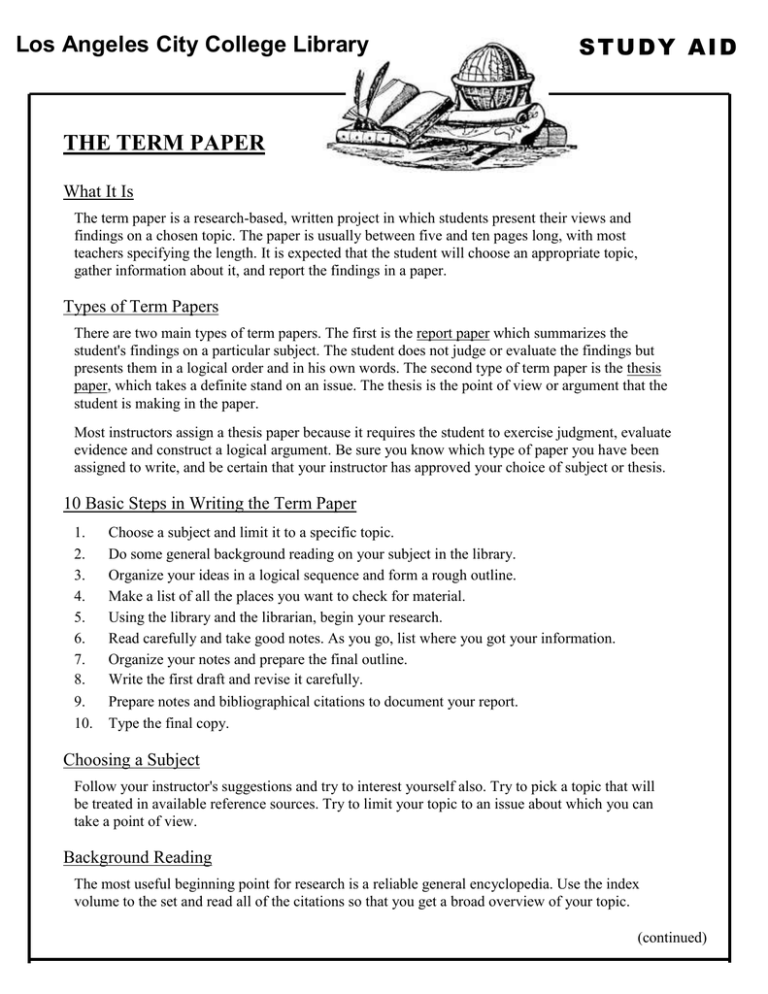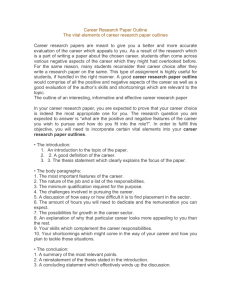STUDY AID Los Angeles City College Library THE TERM PAPER
advertisement

Los Angeles City College Library STUDY AID THE TERM PAPER What It Is The term paper is a research-based, written project in which students present their views and findings on a chosen topic. The paper is usually between five and ten pages long, with most teachers specifying the length. It is expected that the student will choose an appropriate topic, gather information about it, and report the findings in a paper. Types of Term Papers There are two main types of term papers. The first is the report paper which summarizes the student's findings on a particular subject. The student does not judge or evaluate the findings but presents them in a logical order and in his own words. The second type of term paper is the thesis paper, which takes a definite stand on an issue. The thesis is the point of view or argument that the student is making in the paper. Most instructors assign a thesis paper because it requires the student to exercise judgment, evaluate evidence and construct a logical argument. Be sure you know which type of paper you have been assigned to write, and be certain that your instructor has approved your choice of subject or thesis. 10 Basic Steps in Writing the Term Paper 1. 2. 3. 4. 5. 6. 7. 8. 9. 10. Choose a subject and limit it to a specific topic. Do some general background reading on your subject in the library. Organize your ideas in a logical sequence and form a rough outline. Make a list of all the places you want to check for material. Using the library and the librarian, begin your research. Read carefully and take good notes. As you go, list where you got your information. Organize your notes and prepare the final outline. Write the first draft and revise it carefully. Prepare notes and bibliographical citations to document your report. Type the final copy. Choosing a Subject Follow your instructor's suggestions and try to interest yourself also. Try to pick a topic that will be treated in available reference sources. Try to limit your topic to an issue about which you can take a point of view. Background Reading The most useful beginning point for research is a reliable general encyclopedia. Use the index volume to the set and read all of the citations so that you get a broad overview of your topic. (continued) C r e a t e d b y B . V a s q u e z . R e v i s e d J a n u a r y 2 0 0 4 b y A. M e z y n s k i Preliminary Outline The outline is the backbone of a good written report, and the framework for your research. Begin by writing your thesis in one clear, direct sentence. List all the major points you want to develop, or all the questions you want to answer. Sources of Material List all the places you wish to look for material. Develop a card file of 3 x 5 cards, that record all of the sources you use fully. Where to Find Information Begin with the card catalog in the Library Media Center. This is an alphabetical arrangement by author, title and subject of all the books owned by the library. Ask the librarian to help you identify relevant subject headings for your topic. Use the reference center and look for specialized encyclopedias. Use the Readers' Guide to Periodical Literature to locate magazine articles. Be sure to check the pamphlet file on the 4th level of the bookstacks. Using the Sources of Information Look at your sources with a critical eye. Are they current and authoritative? Do they list other places to look? Take good notes in your own words. Do not use too many quotations. Final Outline Arrange your notes into some logical order. There are many different ways to put ideas together. Some subjects are best when put into chronological order. Others are suited to cause and effect or comparison and contrast. Use the library hand-out called "The Outline," for the correct form. Writing and Revising With your outline and note cards before you, begin the first draft. Let all of your ideas pour out. Triple space the page so you have room for corrections Check the draft for logical organization, mechanics of grammar, punctuation and spelling. Be sure that for each idea you have presented good examples that prove your point. Documenting the Report On every page of your report where you have used words, ideas, facts or statistics you have "borrowed," you must credit the source in a footnote. In addition, you must have a bibliography page which lists all of the sources, books, magazine articles and pamphlets that you actually used in preparing your report. The list should be alphabetically arranged by the author's last name. In cases where there is no author, arrange the item in its alphabetical place by the first main word in the title. The library has two hand-outs, "Footnotes, " and "The Bibliography, " to assist you. Pick these up near the reference desk. The Final Report Use standard size typing paper and type single-space on one side only. Indent five spaces for new paragraphs. Prepare a title page, Table of Contents or Outline, the body of the paper and the bibliography. Put the paper inside of a binder. Note: The library has many books on writing the term paper in the 808.02 section. C r e a t e d b y B . V a s q u e z . R e v i s e d J a n u a r y 2 0 0 4 b y A. M e z y n s k i


